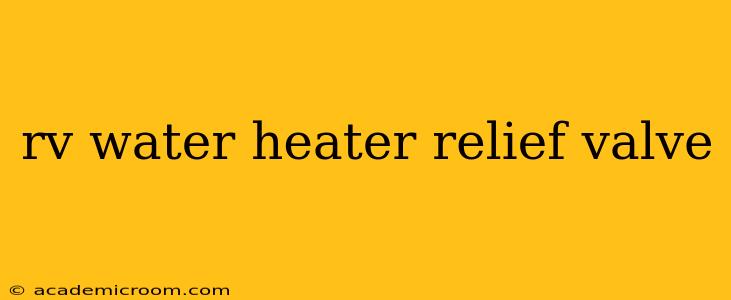Your RV's water heater is a crucial appliance, providing hot water for showers, dishes, and more. A critical safety component of this system is the temperature and pressure relief valve (T&P valve). This valve is designed to prevent potentially dangerous situations by releasing excess pressure and scalding hot water should the temperature or pressure inside the water heater rise to unsafe levels. Understanding how it works, when to test it, and what to do if it malfunctions is essential for every RV owner.
What is an RV Water Heater Relief Valve?
The RV water heater relief valve, often called a T&P valve (Temperature and Pressure Relief Valve), is a safety device that automatically releases water when the pressure or temperature inside the water heater exceeds safe limits. This prevents the tank from rupturing, which could cause significant damage and potential injury. It's a vital part of your RV's plumbing system, ensuring both safety and the longevity of your water heater. Think of it as a pressure release valve, acting as a failsafe to protect against dangerous over-pressurization.
How Does an RV Water Heater Relief Valve Work?
The T&P valve operates on a simple principle: a spring-loaded mechanism. Inside the valve, a spring keeps a small metal disc closed under normal operating pressure. However, if the pressure inside the water heater rises too high (typically due to overheating or excessive water pressure), the pressure overcomes the spring's force, pushing the disc open. This allows hot water to escape, relieving the pressure and preventing a potentially catastrophic failure. Similarly, if the temperature gets too high, a wax pellet within the valve melts, forcing the valve to open. This dual-safety mechanism protects against both high temperature and high pressure scenarios.
What Causes an RV Water Heater Relief Valve to Activate?
Several factors can cause the RV water heater relief valve to activate:
- Overheating: This is the most common cause. If the water heater's thermostat malfunctions or the heating element remains on for too long, the water inside the tank can overheat, building excessive pressure.
- Excessive Water Pressure: A problem with the water supply to your RV, such as a pump malfunction or a sudden pressure surge, can lead to dangerously high water pressure inside the tank.
- Faulty Thermostat: A malfunctioning thermostat might not shut off the heating element at the correct temperature, leading to overheating and subsequent valve activation.
- Sediment Buildup: Over time, sediment can build up in the water heater tank, reducing its efficiency and potentially leading to overheating.
How Often Should You Test Your RV Water Heater Relief Valve?
Testing your RV water heater relief valve regularly is crucial. While manufacturers don't always specify a frequency, many recommend testing it at least once a year, or even more frequently if you're a frequent RV user. This helps ensure the valve is functioning correctly and prevents potential problems before they become serious. Regular testing allows for early detection of a malfunctioning valve.
How to Test Your RV Water Heater Relief Valve?
Testing the T&P valve is a straightforward process:
- Ensure the water heater is OFF and has cooled down. Never attempt to test a hot water heater.
- Place a container under the valve to catch the water. The valve will release hot water, even if the heater is off, due to the residual heat.
- Locate the T&P valve. It's usually found near the top of the water heater.
- Use a lever or the provided testing mechanism (if applicable) to manually lift the valve's lever. If a lever is not present, you can use a long pliers or similar tool to carefully lift the valve pin.
- Observe the water flow. If water flows freely, your valve is working correctly. If there is no water flow, the valve may be malfunctioning and needs replacement.
Warning: If you encounter significant resistance when attempting to lift the valve, stop immediately. Forcefully opening a stuck valve could cause damage.
What to Do if Your RV Water Heater Relief Valve is Leaking?
A constantly dripping or leaking T&P valve is a sign of a problem. Ignoring this issue is risky, as a malfunctioning valve could ultimately lead to a water heater rupture.
- Identify the source of the leak. Is it the valve itself, or is there another leak nearby?
- If the valve is malfunctioning, it likely needs to be replaced. This is a job best left to a qualified RV technician or plumber, especially if you are not comfortable with plumbing repairs. Improper installation can lead to further problems.
- Do not attempt to repair the valve yourself unless you have the necessary expertise. Improper repairs can make the situation worse and compromise safety.
What Size RV Water Heater Relief Valve Do I Need?
The size of the relief valve required for your RV water heater will depend on the capacity of the water heater. Check your water heater's specifications for the correct size. This information is crucial for proper safety. Don't guess - use the manufacturer's recommended size.
Can I Replace My RV Water Heater Relief Valve Myself?
While theoretically possible, replacing an RV water heater relief valve is generally not recommended for someone without plumbing experience. It requires careful handling to avoid leaks and ensure proper installation, thereby maintaining safety standards. If you lack experience, it's best to hire a qualified professional.
This comprehensive guide provides essential information about RV water heater relief valves, ensuring the safety and longevity of your RV's plumbing system. Remember to prioritize safety and seek professional help when necessary.
